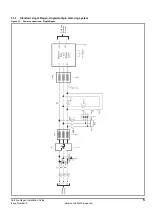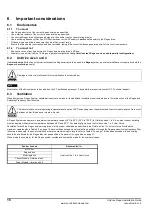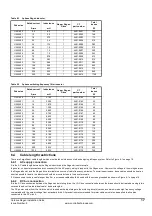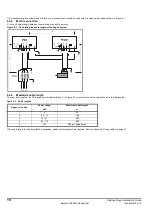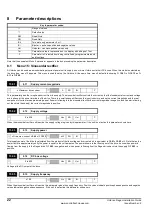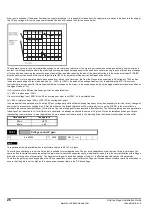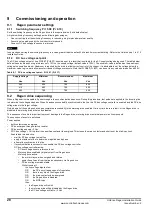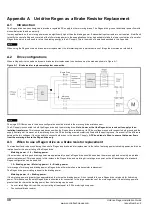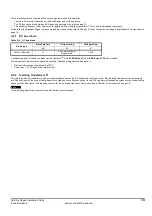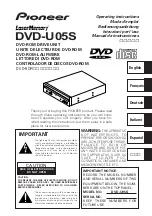
Unidrive Regen Installation Guide
19
Issue Number: 2
www.controltechniques.com
7
Unidrive Regen EMC information
7.1
Immunity
The immunity of the individual drive modules is not affected by operation in the regenerative mode. See drive EMC data sheets for further information.
This Guide recommends the use of varistors between the incoming AC supply lines. These are strongly recommended to protect the drive from
surges caused by lightning activity and/or mains supply switching operations.
Since the regenerative input stage must remain synchronised to the supply, there is a limit to the permitted rate of change of supply frequency. If rates
of change exceeding 100Hz/s are expected then C.T. Technical Support should be consulted. This would only arise under exceptional circumstances
e.g. where the power system is supplied from an individual generator.
7.2
Emission
Emission occurs over a wide range of frequencies. The effects are divided into three main categories:
•
Low frequency effects, such as supply harmonics and notching
•
High frequency emission below 30MHz where emission is predominantly by conduction
•
High frequency emission above 30MHz where emission is predominantly by radiation
7.3
Dedicated supplies
The nature of the mains supply has an important effect on the EMC arrangements. For a dedicated supply, i.e. one which has no other electrical
equipment fed from the secondary of its distribution transformer, normally neither an RFI filter or a switching frequency filter are required. Refer to
section 3.2.2 Supply assessment on page 7.
7.4
Other supplies
Wherever other equipment shares the same low voltage supply, i.e. 400Vac, careful consideration must be given to the likely need for both switching
frequency and RFI filters, as explained in section 7.7 Switching frequency emission and section 7.8 Conducted RF emission .
7.5
Supply voltage notching
Because of the use of input inductors and an active rectifier the drive causes no notching - but see section 7.7 Switching frequency emission for
advice on switching frequency emission.
7.6
Supply harmonics
When operated from a balanced sinusoidal three-phase supply, the regenerative Unidrive generates minimal harmonic current.
Imbalance between phase voltages will cause the drive to generate some harmonic current. Existing voltage harmonics on the power system will
cause some harmonic current to flow from the supply into the drive. Note that this latter effect is not an emission, but it may be difficult to distinguish
between incoming and outgoing harmonic current in a site measurement unless accurate phase angle data is available for the harmonics. No general
rule can be given for these effects, but the generated harmonic current levels will always be small compared with those caused by a conventional
drive with rectifier input.
7.7
Switching frequency emission
The Regen drive uses a PWM technique to generate a sinusoidal input voltage phase-locked to the mains supply. The input current therefore
contains no harmonics of the supply unless the supply itself contains harmonics or is unbalanced. It does however contain current at the switching
frequency and its harmonics, modulated by the supply frequency. For example, with a 3kHz switching frequency and 50Hz supply frequency there is
current at 2.95, 3.15, 5.95, 6.05kHz etc. The switching frequency is not related to that of the supply, so the emission will not be a true harmonic - it is
sometimes referred to as an “interharmonic”. The possible effect of this current is similar to that of a high-order harmonic, and it spreads through the
power system in a manner depending on the associated impedances. The internal impedance of the Regen drive is dominated by the series inductors
at the input. The voltage produced at switching frequency at the supply point is therefore determined by the potential divider action of the series
inductors and the supply impedance; section 3.2.2 Supply assessment on page 7 gives guidelines to help in assessing whether a switching-
frequency filter is required. In case of doubt, unless the drive operates from a dedicated supply not shared with other loads, it is strongly
recommended that the filter be fitted.
7.8
Conducted RF emission
Radio frequency emission in the frequency range from 150kHz to 30MHz is mainly conducted out of the equipment through electrical wiring. It is
essential for compliance with all emission standards, except for IEC61800-3 second environment, that the recommended RFI filter and a shielded
(screened) motor cable are used. Most types of cable can be used provided it has an overall screen. For example, the screen formed by the
armouring of steel wired armoured cable is acceptable. The capacitance of the cable forms a load on the drive and should be kept to a minimum.
Failure to fit a switching frequency filter may result in damage to other equipment, e.g. fluorescent light fittings, power factor correction
capacitors and RFI filters.
CAUTION

